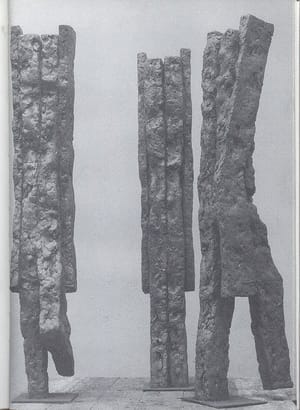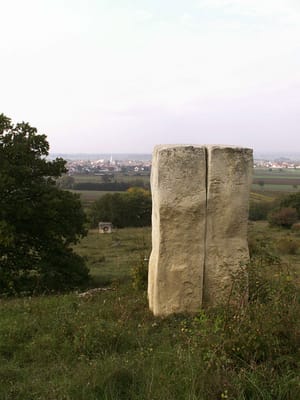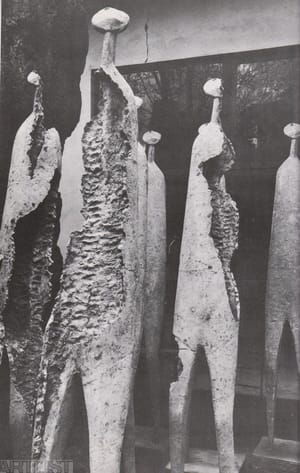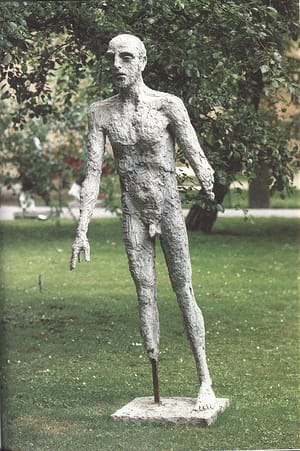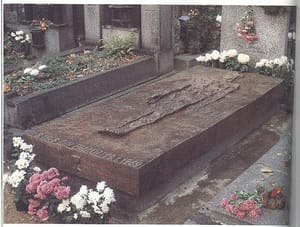- First Name
- Olbram
- Surname
- Zoubek
- Born
- 1926
- Birth place
- Praha
- Place of work
- Praha
- Died
- 2017
- Keywords
- CSU Library
- ↳ Find in the catalogue
About artist
While the general public perceives Zoubek as a one position sculptor – creating rather impassioned sculptures evoking ancient theatre, which, following 1989 sometimes slipped all the way to the decorative style – if we take a closer look, we will see a sculptor who has had a very interesting and complicated development. It reflects the many problems that Czech art was faced with – primarily the loss of continuity after WWII, the difficulty in regaining it on the break of the 1950s and 1960s, and at the end of this decade also a fleeting contact with international sculpture.
Olbram Zoubek belongs to the strong generation that entered the scene after WWII. If Jindřich Chalupecký once remarked that in the generation of the 1940s, Ladislav Zívr was the only sculptor, then Zoubek’s generation was the last one in Czech art where sculpture dominated. In the beginning (until the beginning of 1960s), this generation could not deal with the existing issues of contemporary sculpture because it did not know it and it was preoccupied with other problems in the local conditions. There was nothing else to do than to follow up on the classics of Czech and international modernism – in Zoubek’s case these included Zadkine, Lipchits or Wotruba, as well as Miró or Léger. Sometime around 1965, sculpting symposia became an important source of information for local sculptors, and our environment was actually very close to them as they originated “around the corner” in Austria. Today we know that symposia were a phenomenon that contained many conservative or even retrogressive elements. This is actually valid also for the delayed touch of abstraction (at that time current in the Czech environment), which is linked to this group and played a certain role primarily in Zoubek’s work. His sculptures from Sankt Margarethen, Vyšné Ružbachy or Oggelshausen, free of any shape, encouraged by the founder of the symposia Karl Prantl, still have a figurative core. Let’s pause to recall that at this time he experienced his actually greatest breakthrough within the international context when in 1969 his sculpture from Sankt Margarethen was featured on the front page of a retrospective catalogue for the 10th anniversary of this historically first symposium.
From an art-historical perspective Zoubek was unlucky in a way for being born in such a strong generation, as a result of which he stood in the shadows of his peers whether it was Palcr, Chlupáč, Sekal, Kolíbal or his wife Eva Kmentová (naming just sculptors). But his sculptures-symbols from the break of 1950s and 1960s, his very strange sculpture group of a pair of engineers Malátek and Loos with the gestures of suppliants (1964), or his already mentioned sculptures bordering abstract stelas, co-created that overflowing creative atmosphere in the pressure cooker of the Czech basin of the 1960s, which was a mixture and cooperation of several generations and opinion streams. And it was certainly no coincidence that he belonged to the wider circle around Jindřich Chalupecký and that he was represented in 1967 at the exhibition Pět sochařů (Five Sculptors) in the Špálova Gallery. It may come as a surprise today that we can also find him among the participants of underground events such as Setkání na tenisových dvorcích v Praze (Meeting at the Tennis Courts in Prague) (1982), but Zoubek, although he was a classical sculptor, belonged to the core of the back then cultural opposition. This was confirmed also by the army of his statues at the exhibition Forum 88 in Holešovická tržnice – the first representative presentation of the Czech unofficial scene. In the spirit of this, he became the president of Nová skupina (New Group) in 1990 which was initiated by Chalupecký. This group, however, did not have a chance to become a fundamental platform because the circumstances had radically changed and Chalupecký’s principles, valid during the time when there was a lack of freedom, were suddenly no longer attractive for artists. Intergenerational solidarity lost its meaning in the new world, and all of a sudden the most important thing was individual performance.
In the renewed freedom Zoubek broke through like no one else and he was struck by the unhappy destiny of being a living classical artist, which does not necessarily mean a benefit for the artist and his work. He was, for example, quite harmed by the unlucky monograph from 1996 published as an honour to him by the Masaryk University – this concise art-historical and commemorative material turned out to be embarrassing from the typographical, as well as printing aspect. Today his work may appear to be too literary, impassioned and – as is the case of his memorial at Újezd – almost stage managed. In a way it is also encumbered by the period prior to 1989, because today we have the tendency to perceive it exactly in its context – as a private revolt against its shallowness, like a morality... And although I’m afraid that the new generations of young art historians will not have such sympathies for Zoubek’s work like those who had the chance to be influenced by its dignified and pleasant appearance (for that matter, something similar happened to another icon of Czech art, Mikuláš Medek), his work has unquestionable qualities that cannot be disregarded together with that superficial public interest that accompanies him today.
- Author of the annotation
- Marcel Fišer
- Published
- 2010
CV
1945-1952 Academy of Arts, Architecture and Design in Prague (prof. Josef Wagner)
- Member of art groups included in ARTLIST.
Exhibitions
- Solo exhibitions
-
2009
Dvojice. VS Atrium, Praha.
2008
Sochy, Městská galerie Hradec nad Moravicí.
Sochy, kostelík sv. Máří Magdaleny na Skalce u Mníšku pod Brdy.
2007
Sochy, plastiky, Galerie pod Radnicí, Zlín.
2006
Sochy, Ovocný trh, Praha.
Sochy, Galerie Bayer & Bayer, Praha.
Galerie Mona Lisa, Olomouc.
2001
Nad mraky je nebe vždy modré, Galerie Mona Lisa, Olomouc.
1998
L'Homme des printemps, Château du Grand Jardin.
1997
Výtvarné centrum Chagall, Ostrava.
Sochy, Tiskárna JDS, Praha.
Městské muzeum a galerie, Litomyšl.
1996
Státní galerie výtvarného umění v Náchodě.
Sochy, reliéfy, Galerie U Klicperů, Hradec Králové.
Sochy a reliéfy, Galerie MAG, Jablonec nad Nisou.
Nadace Universitas Masarykiana v Brně, Brno.
Dům umění v Opavě.
1995
Výstavní síň Synagoga, Hranice.
Josef Istler: Monotypy, Bronzy z let 1992 - 1995, Galerie Magna, Ostrava.
Galerie MK, Rožnov pod Radhoštěm.
1993
Plastiky, tisky. Galerie Gema, Praha.
Galerie Peithner-Lichtenfels, Vídeň.
1991
Sochy (2. díl), Staroměstská radnice, GHMP Praha.
Sochy (1. díl), Vojanovy sady, Praha.
1990
Sochy, reliéfní otisky, Galerie U Bílého jednorožce, Galerie Klatovy / Klenová.
Sochy, Arnoldinovský dům, Brandýs nad Labem-Stará Boleslav.
Olbram Zoubek sochař a grafik, Galerie D, Ostrava.
Galerie Delta, Frýdek-Místek.
1989
Sochy, Zámek Bruntál.
Sochy, Galerie Jaroslava Krále, Brno.
Reliéfní otisky, Kino Metro 70, Prostějov.
Plastiky, Studio Městského domu kultury Petra Bezruče, Opava.
Galerie Opatov, Praha.
1988
Výstavní síň Kniha - metro Leninova, Praha.
Sochy, Sovinec.
1987
Plastiky, Galerie Zlatá lilie Praha.
1986
Výběr z díla 1958 - 1986, Letohrádek Ostrov, Galerie umění Karlovy Vary.
Sochy, Atrium na Žižkově, výstavní síň, Praha.
1985
Sochy, Zbrašovské aragonitové jeskyně, Teplice nad Bečvou.
Reliéfní tisky, Malá galerie České spořitelny, Kladno.
1984
Figury, Galerie 55, Kladno.
1983
Komorní tvorba, Galerie Zlatá lilie, Praha.
1982
Sochy. Okresní vlastivědné muzeum Frýdek-Místek.
Sochy a reliéfy. Ústav makromolekulární chemie Praha.
1981
Výběr ze sochařského díla. Orlická galerie v Rychnově nad Kněžnou.
1980
Padesát plastik Olbrama Zoubka. Ústřední kulturní dům železničářů, Praha.
Komorní plastiky. Okresní vlastivědné muzeum Bruntál.
1978
Sochy. Arboretum Stěbořice.
- Group exhibitions not included in ARTLIST.
-
2008
Pohledy do sbírek Severočeské galerie výtvarného umění v Litoměřicích, Severočeská galerie výtvarného umění v Litoměřicích.
2007
Umělecká beseda: Vědomí o člověku, Výstavní síň Masné krámy, Plzeň
Od sochy ...: České sochařství 2. poloviny 20. století ze sbírek Galerie Klatovy / Klenová, Galerie U Bílého jednorožce, Klatovy
Členská výstava Umělecké besedy, Novoměstská radnice, Praha
Členská výstava Umělecké besedy, Muzeum a galerie Orlických hor, Rychnov nad Kněžnou
2005
Privátní pohled (Sbírka Josefa Chloupka), Dům umění Brno.
2002
Anima & Animus (manželské páry v generaci 60. let), Galerie Zlatá husa, Praha
2001
Barevná socha, Severočeská galerie výtvarného umění v Litoměřicích
2000
Umělecká beseda 1999/2000, Mánes, Praha 1
Pomník Franzi Kafkovi, Galerie Franze Kafky, Praha
Alfa 2000 omega, Galerie moderního umění v Roudnici nad Labem, Roudnice nad Labem, OGV Jihlava
100 + 1 uměleckých děl z dvacátého století, Dům U černé Matky Boží, Praha
1999
Umění zrychleného času. Česká výtvarná scéna 1958 - 1968, Praha, Státní galerie výtvarného umění v Chebu
Obraz, socha a svět, Mánes
1998
Umělecká beseda 1998, Mánes
1997
Umělecká beseda, Galerie Bayer & Bayer, Mostecká 16, Praha
Otevřený dialog, Kostel Zvěstování Panny Marie, Litoměřice
1996
Zpřítomnění, Přírůstky galerie z let 1987 - 1994, Zámek Klenová, Klenová
Umění zastaveného času, Česká výtvarná scéna 1969-1985, ČMVU Praha, Státní galerie výtvarného umění v Chebu,
Umělecká beseda 1996, Mánes
Slyšme hlas, Klášter premonstrátů, Praha
Novozákonní motivy v Českém umění 20. století, Galerie moderního umění v Roudnici nad Labem, Galerie umění Karlovy Vary
I. nový zlínský salon, Zlín
1995
Umělecká beseda 1995, Mánes
Starozákonní motivy v českém umění dvacátého století, Galerie moderního umění v Roudnici nad Labem, Galerie umění Karlovy Vary,
České výtvarné umění XX. století ze sbírek ČMVU, Dům U černé Matky Boží, Praha
1994
Umělecká beseda 1994, Mánes
Ohniska znovuzrození, Městská knihovna, Praha
1993
Nová figurace, Galerie výtvarného umění, Litoměřice, Východočeská galerie v Pardubicích, Moravská galerie v Brně, Dům umění v Opavě, Oblastní galerie Vysočiny v Jihlavě
1992
Umělecká beseda 1992, Mánes
Svetlo v tmách, Považská galéria umenia, Žilina
Minisalon, Galerie Nová síň, Praha
Duch a světlo, Galerie Sýpka, Vlkov
České výtvarné umění 1900 1960, Středočeská galerie, Praha
Barok a dnešek, Kostel Zvěstování Panny Marie, Litoměřice
20 let výtvarných výstav v Makru (1972 - 1992), Ústav makromolekulární chemie Praha
1991
Proti zdi, Galerie Fronta, Praha
Europäische Dialoge 1991 / 1. festival Des Europäischen Kulturklubs, Museum Bochum, Bochum
Československo-francouzská výstava, Sovinec, Sovinec
Tradition und Avantgarde in Prag, Rheinisches Landesmuseum, Bonn
Tradition und Avantgarde in Prag, Kunsthalle Dominikanerkirche, Osnabrück
Šedá cihla 78/1991, Zámek Klenová, Klenová Dům umění v Opavě, Opava
Hořící keř, Emauzy, Praha
České malířství a sochařství 2. poloviny 20. století ze sbírek AJG, Alšova jihočeská galerie v Hluboké nad Vltavou, Hluboká nad Vltavou
1990
Pocta umělců Jindřichovi Chalupeckému, Městská knihovna, Praha
Nová skupina: Členská výstava, Městská knihovna, Praha
Nová skupina: Členská výstava, Dům umění v Opavě
1989
Tendence v českém sochařství 1979 - 1989, Bezručovy sady, Olomouc
Miroslav Šnajdr: Obrazy, Olbram Zoubek: Sochy, Lyra Pragensis (Divadlo hudby), Praha
České sochařství 1948 - 1988, Krajské vlastivědné muzeum, Olomouc
1988
Salón pražských výtvarných umělců '88, Park kultury a oddechu Julia Fučíka, Praha
Jeden starší - jeden mladší. Obrazy, sochy, realizace, Lidový dům, Praha
Forum 1988, Holešovická tržnice, Praha
1986
Výzva 1986, Výtvarné dialogy o minulosti a přítomnosti lidstva, Výstava k Mezinárodnímu roku míru, Dům umění města Brna
Václav Boštík, Zdeněk Palcr, Stanislav Podhrázský, Olbram Zoubek, Galerie Josefa Matičky, Litomyšl
Drobná plastika, Galerie Platýz, Praha
1985
Vyznání životu a míru. Přehlídka československého výtvarného umění k 40. výročí osvobození Československa Sovětskou armádou, Praha, Praha Dom kultúry, Bratislava (Bratislava)
Barevná socha, Galerie H , Kostelec nad Černými lesy (Praha-východ)
1984
Záznam o činnosti, Galerie H , Kostelec nad Černými lesy (Praha-východ)
Výtvarné umění a hudba, Galerie Vincence Kramáře, Praha
Čtyřverší, Galerie H , Kostelec nad Černými lesy (Praha-východ)
1983
Prostor, architektura, výtvarné umění, Výstaviště Černá Louka, Ostrava
1982
Setkání na tenisových dvorcích, Tenisové dvorce TJ Sparta Praha, Praha
1980
Výtvarní umělci k 35. výročí osvobození Československa Sovětskou armádou, Praha, Praha
1970
Tschechische Skulptur des 20. Jahrhunderts: Von Myslbek bis zur Gegenwart, Schloß Charlottenburg - Orangerie, Berlín.
1969
Nová figurace, Mánes, Praha 1
2. pražský salón (obrazů, soch a grafik), Dům U Hybernů, Praha
1968
Věčné dialogy, Oblastní muzeum v Písku
Socha piešťanských parkov '68, Kúpelový ostrov, Piešťany
Deset sochařských vyznání, Galerie Fronta, Praha
300 malířů, sochařů, grafiků 5 generací k 50 létům republiky, Praha, Praha
1967
Umělci k výročí Října, Bruselský pavilon, Praha
5 sochařů, Galerie Václava Špály, Praha
1. pražský salon, Bruselský pavilon, Praha
1966
Tschechoslowakische Plastik von 1900 bis zur Gegenwart, Museum Folkwang, Essen
Jarní výstava 1966, Mánes,
Aktuální tendence českého umění. Obrazy, sochy, grafika, Praha, Praha
1965
Sochařská bilance 1955-1965, Olomouc
1964
Výstava soutěžních návrhů na výzdobu nového velvyslanectví v Brazílii, Galerie Václava Špály, Praha
Trasa, Galerie Václava Špály, Praha
Socha 1964, Liberec
1963
Rychnov 1963, Zámek Rychnov nad Kněžnou
Jarcovják, Vaca, Zoubek, Galerie Václava Špály, Praha
1961
Tvůrčí skupina Trasa, Galerie Československý spisovatel, Praha
Realizace, Galerie Václava Špály, Praha
1959
4. přehlídka československého výtvarného umění, Praha.
1958
Umění mladých výtvarníků Československa 1958. Obrazy a plastiky, Dům umění města Brna, Jízdárna Pražského hradu, Praha.
1953
II. krajské středisko Umělecká beseda: Členská výstava, Valdštejnský palác, Praha.
1953
Členská výstava Umělecké besedy, Slovanský ostrov, Praha.

